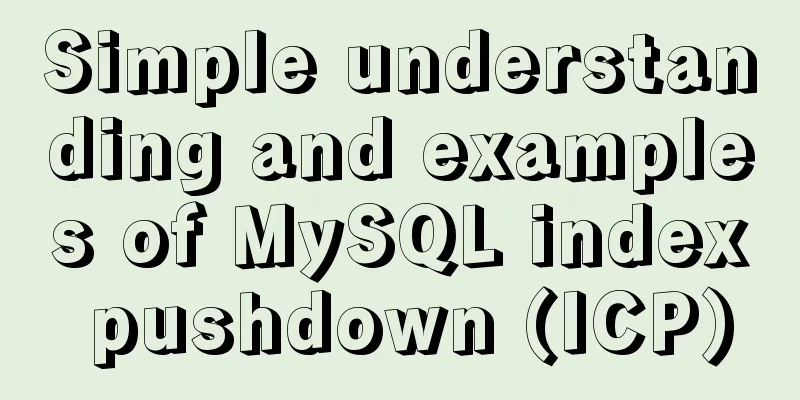Simple understanding and examples of MySQL index pushdown (ICP)

PrefaceIndex Condition Pushdown (ICP) is a new feature of MySQL 5.6. It can reduce the number of table queries and improve retrieval efficiency. MySQL ArchitectureTo understand index pushdown, you must first understand the architecture of MySQL:
The above picture is from the official MySQL documentation. MySQL is usually divided into the following layers from top to bottom:
The MySQL service layer is responsible for SQL syntax parsing, triggers, views, built-in functions, binlog, generating execution plans, etc., and calls the storage engine layer to perform data storage and retrieval. The "down" in "index push down" actually means that some of the tasks that are the responsibility of the upper layer (service layer) are handed over to the lower layer (storage engine) for processing. Index pushdown exampleAssume that the user table data and structure are as follows:
Create a joint index (age, birthday) and query users whose age is > 20 and whose birthday is 03-01: select * from user where age>20 and birthday="03-01" Because the age field uses a range query, according to the leftmost prefix principle, in this case only the age field can be used for range query, and the birthday field in the index cannot be used. Use explain to view the execution plan: +------+-------------+-------+-------+---------------+--------------+--------+------+------+------+-----------------------+ | id | select_type | table | type | possible_keys | key | key_len | ref | rows | Extra | +------+-------------+-------+-------+---------------+--------------+--------+------+------+------+-----------------------+ | 1 | SIMPLE | user | range | age_birthday | age_birthday | 4 | NULL | 3 | Using index condition | +------+-------------+-------+-------+---------------+--------------+--------+------+------+------+-----------------------+ It can be seen that although the age_birthday index is used, the index length key_len is only 4, which means that only the age field of the joint index is effective (because the age field is of int type and occupies 4 bytes). Finally, the Using index condition in the Extra column indicates that this query uses index push-down optimization. To perform the following steps without index pushdown:
If index pushdown optimization is enabled, the execution steps are as follows:
After enabling index pushdown, the where condition is moved from the MySQL service layer to the storage engine layer for execution. The benefit is that the storage engine reads data from the table less often based on the ID. In the above example, when there is no index pushdown, the table needs to be queried twice more. In addition, table query is likely to be discrete IO, which can significantly improve database performance in some cases. SummarizeThis concludes this article on the simple understanding and examples of MySQL Index Pushdown (ICP). For more relevant MySQL Index Pushdown (ICP) content, please search for previous articles on 123WORDPRESS.COM or continue to browse the following related articles. I hope you will support 123WORDPRESS.COM in the future! You may also be interested in:
|
<<: The implementation code of the CSS3 input box is similar to the animation effect of Google login
>>: The docker prune command can be used to periodically clean up infrequently used data
Recommend
MySQL grouping queries and aggregate functions
Overview I believe we often encounter such scenar...
Linux server SSH cracking prevention method (recommended)
1. The Linux server configures /etc/hosts.deny to...
How to install and configure the decompressed version of MySQL database under Linux system
1. Unzip the file to the current directory Comman...
Detailed tutorial for upgrading zabbix monitoring 4.4 to 5.0
1. Zabbix backup [root@iZ2zeapnvuohe8p14289u6Z /]...
100 ways to change the color of an image using CSS (worth collecting)
Preface “When it comes to image processing, we of...
MySQL database development specifications [recommended]
Recently, we have been capturing SQL online for o...
JavaScript implements the nine-grid mobile puzzle game
This article shares the specific code for JavaScr...
Uniapp uses Baidu Voice to realize the function of converting recording to text
After three days of encountering various difficul...
MySQL aggregate function sorting
Table of contents MySQL result sorting - Aggregat...
Detailed explanation of Mysql transaction isolation level read commit
View MySQL transaction isolation level mysql> ...
MySQL multi-instance installation boot auto-start service configuration process
1.MySQL multiple instances MySQL multi-instance m...
A detailed explanation of the overlapping and soft color matching method in web page color matching
This article does not have any quibbles, it is jus...
Web design tips on form input boxes
This article lists some tips and codes about form...
Vue implements file upload and download
This article example shares the specific code of ...
Detailed explanation of how to automatically refresh the page and refresh method after deleting Vue list data
Problem description: After the front-end deletes ...










